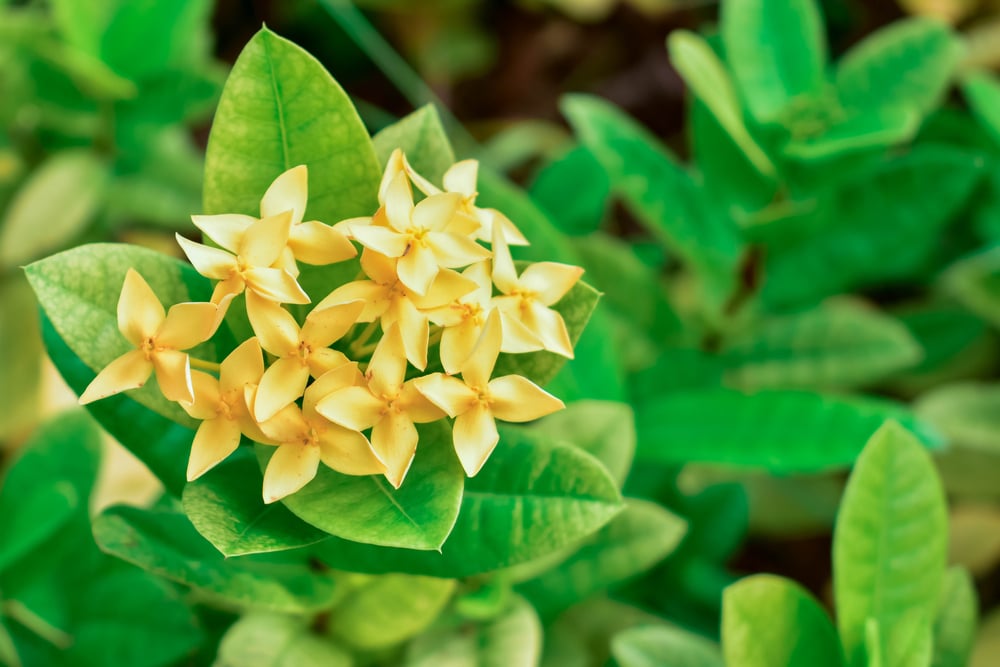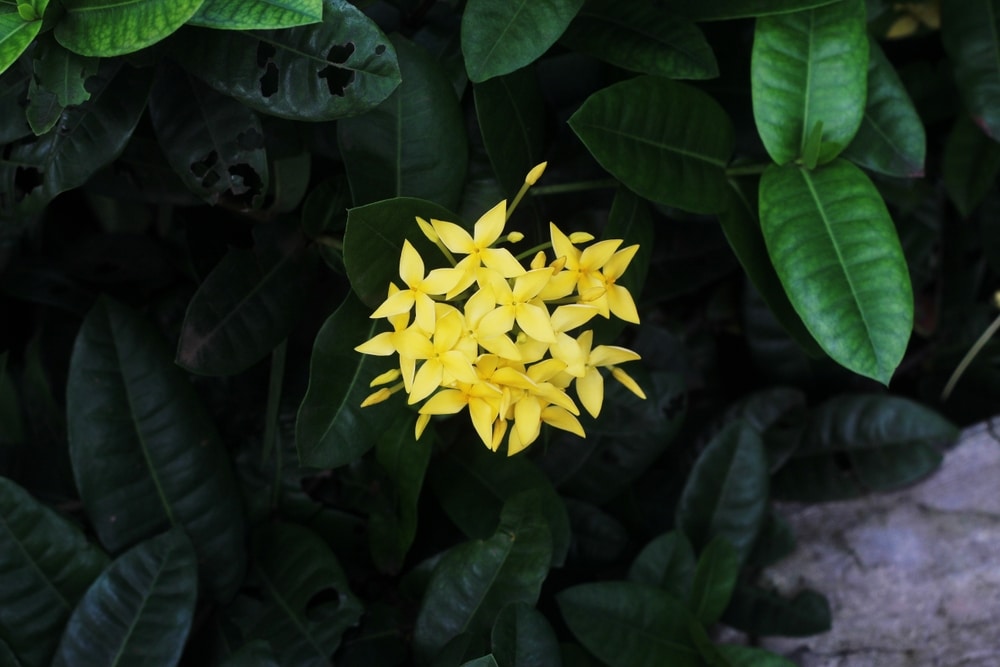The Maui Ixora is a beautiful flowering shrub that produces clusters of small, bright flowers. Thanks to its long blooming period, this ornamental plant has become more popular as an accent or border planting in tropical gardens.
It is also used as a landscape specimen or liner on a deck or porch. Its versatility, combined with its ease of care, has made it a top choice for home gardeners. Native to India, Sri Lanka, and other parts of Southeast Asia, Maui Ixora graces gardens with its glossy, dark green leaves and showy flowers.

| Botanical Name | Ixora Coccinea ‘Maui’ |
| Common Name | Ixora, Maui Sunset, Jungle Flame |
| Plant Type | Perennial |
| Flower Color | Red flowers in clusters |
| Size When Mature | 36 Inches |
| Bloom Time | Late Winter to Late Fall |
| Sun Requirements | Full Direct Sunlight |
| USDA Hardiness Zones | 9 – 11 |
| Soil PH Range | 5.5-6.5 |
| Soil Type | Slightly Acidic, Rich, Well-drained |
| Water Needs | Medium |
| Native Area | Southeast Asia |
What You Need to Know About Maui Ixora
Unlike many other plants, the Maui Ixora does not bloom in summer or spring. Instead, it produces red flowers in clusters forming the shape of a ball during late winter to late fall. The blooms last for about two to two and a half months.
Its rounded shape and dense foliage, partnered with dark green and glossy leaves, make it an excellent shrub to border your garden or to use as a specimen plant. You’ll notice that its leaves are also arranged in opposite pairs along the stem, which is typical of most Ixora plants.
Its leaves eventually turn lighter in color in spring but will return to their original deep green hue as the temperature rises.
Additionally, pet owners will be happy to know that this plant is non-toxic. The entire plant is safe to be around pets and children. With its low-maintenance and drought-tolerant nature, the Maui Ixora is an ideal plant for those who want to enjoy tropical beauty without having to put in a lot of work.
It is fairly drought tolerant once established but will benefit from regular watering during prolonged periods of drought. It is also relatively salt tolerant. While it doesn’t require regular pruning, you may trim it to shape as needed and eliminate spent flowers.
How to Care for Maui Ixora
Here’s everything you need to know about growing and caring for a thriving Maui Ixora:
Light
The beautiful Maxi Ixora loves being soaked under the sun. Its deep green and thick foliage are best achieved when exposed to full sun. It thrives and grows happily when exposed to at least 8 hours of sunlight daily.
Although if you can’t find a spot in your yard that gets full sun, a bit of partial shade and dappled sunlight will also work. Just make sure it doesn’t get too much shade, or it may get leggy as a result. When grown indoors, find a sunny and warm location by the window. You may rotate the plant every once in a while to ensure that all sides and leaves get an equal amount of sunlight.
Water and Soil Needs
Maui Ixora in slightly acidic soil with pH levels of 5.5 to 6.5 does and bloom well. It prefers its soil to be well draining and fertile, although it can survive and can adapt to different soil conditions.
This plant is moderately drought tolerant and salt tolerant too. It needs to be watered deeply regularly, at least once a week, and even less during the winter. The soil should be kept moist but not wet and soggy.
Temperature Requirements
They are one of the least cold tolerant plants among tropicals. These plants grow best in USDA zones 9 through 11 and prefer warm and humid soil and outdoor temperatures.
Fertilizer
The best fertilizer to use on a Maui Ixora is an organic fertilizer. Additionally, adding a layer of compost around the plant’s base is ideal, making sure that you don’t overdo it. Try not to bury the stem of the plant when adding compost, as this may cause it to rot.
We’ve suggested organic fertilizer for this plant since it can lower the soil’s pH levels. Since Maui Ixora prefers slightly acidic soil, this fertilizer type will help to keep the pH levels in check.
Common Diseases
Though these plants are generally trouble-free, they are still prone to a few common Ixora pests and diseases. For example, spider mites and aphids can be a problem, especially during the hot and dry summer months.
These pests can infest your plant and cause yellowing of the leaves, but they can be easily controlled with either a commercial insecticidal soap or a DIY version made with dish soap and water.
Additionally, Ixoras are susceptible to a fungal infection called Anthracnose. Black, tan, or red spots will start to appear on its foliage. The leaves will begin to wilt, turn yellow, and fall from the plant. The stems may develop blackish cankers.
Using fungicides is not recommended, so removing infected branches and leaves. The best way to deal with it is to change your watering methods. Avoid getting the leaves wet as this will only spread the infection.
In general, keeping the plants free from stress will also help prevent them from being prone to pests and diseases.
Maui Ixora Propagation
For Maui Ixora, it’s worth noting that rooting this plant is quite challenging. Although you can propagate from cuttings, using a rooting hormone is one of the best ways to increase your success rate.
Keep the soil in a warm and humid environment and make sure to water regularly. Bottom heat can also be used to speed up the process.
Similar to how you’d propagate other plants, take a cutting and snip right below the node. Remember to get rid of the lower leaves, leaving the top leaves intact. There’s no need to air-dry, but dipping the end of the cutting into a rooting hormone will give it a boost.
Place the cuttings in their ideal soil conditions, ensuring that the soil is moist but not wet. If you have a dome, you can place the cutting inside to create a mini greenhouse effect.
Do not forget to provide bottom heat if possible, as this will make the process go by faster. Rooting generally takes place within 4 to 8 weeks.
Related Article: Dwarf Ixora Care

